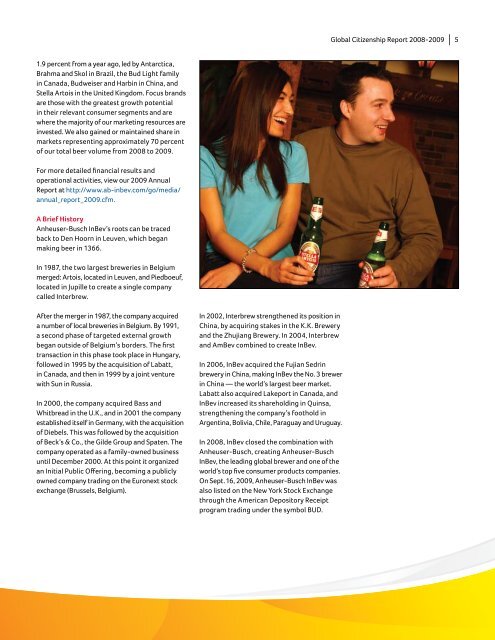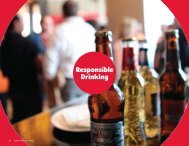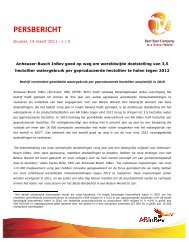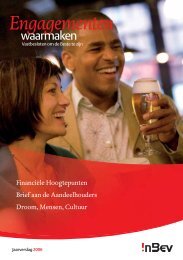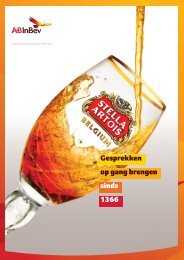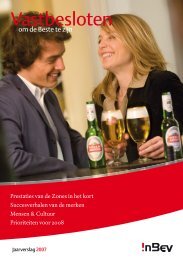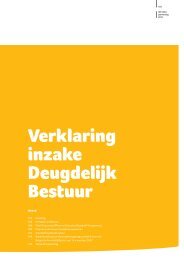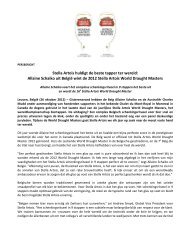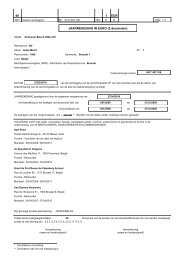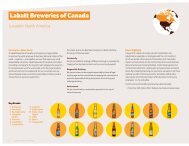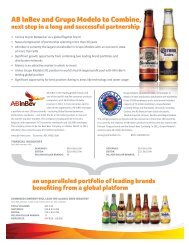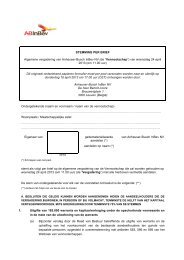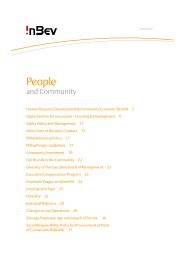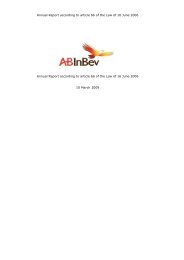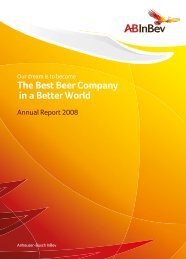Beer & A Better World - Anheuser-Busch InBev
Beer & A Better World - Anheuser-Busch InBev
Beer & A Better World - Anheuser-Busch InBev
You also want an ePaper? Increase the reach of your titles
YUMPU automatically turns print PDFs into web optimized ePapers that Google loves.
1.9 percent from a year ago, led by Antarctica,<br />
Brahma and Skol in Brazil, the Bud Light family<br />
in Canada, Budweiser and Harbin in China, and<br />
Stella Artois in the United Kingdom. Focus brands<br />
are those with the greatest growth potential<br />
in their relevant consumer segments and are<br />
where the majority of our marketing resources are<br />
invested. We also gained or maintained share in<br />
markets representing approximately 70 percent<br />
of our total beer volume from 2008 to 2009.<br />
For more detailed financial results and<br />
operational activities, view our 2009 Annual<br />
Report at http://www.ab-inbev.com/go/media/<br />
annual_report_2009.cfm.<br />
A Brief History<br />
<strong>Anheuser</strong>-<strong>Busch</strong> <strong>InBev</strong>’s roots can be traced<br />
back to Den Hoorn in Leuven, which began<br />
making beer in 1366.<br />
In 1987, the two largest breweries in Belgium<br />
merged: Artois, located in Leuven, and Piedboeuf,<br />
located in Jupille to create a single company<br />
called Interbrew.<br />
After the merger in 1987, the company acquired<br />
a number of local breweries in Belgium. By 1991,<br />
a second phase of targeted external growth<br />
began outside of Belgium’s borders. The first<br />
transaction in this phase took place in Hungary,<br />
followed in 1995 by the acquisition of Labatt,<br />
in Canada, and then in 1999 by a joint venture<br />
with Sun in Russia.<br />
In 2000, the company acquired Bass and<br />
Whitbread in the U.K., and in 2001 the company<br />
established itself in Germany, with the acquisition<br />
of Diebels. This was followed by the acquisition<br />
of Beck’s & Co., the Gilde Group and Spaten. The<br />
company operated as a family-owned business<br />
until December 2000. At this point it organized<br />
an Initial Public Offering, becoming a publicly<br />
owned company trading on the Euronext stock<br />
exchange (Brussels, Belgium).<br />
In 2002, Interbrew strengthened its position in<br />
China, by acquiring stakes in the K.K. Brewery<br />
and the Zhujiang Brewery. In 2004, Interbrew<br />
and AmBev combined to create <strong>InBev</strong>.<br />
In 2006, <strong>InBev</strong> acquired the Fujian Sedrin<br />
brewery in China, making <strong>InBev</strong> the No. 3 brewer<br />
in China — the world’s largest beer market.<br />
Labatt also acquired Lakeport in Canada, and<br />
<strong>InBev</strong> increased its shareholding in Quinsa,<br />
strengthening the company’s foothold in<br />
Argentina, Bolivia, Chile, Paraguay and Uruguay.<br />
In 2008, <strong>InBev</strong> closed the combination with<br />
<strong>Anheuser</strong>-<strong>Busch</strong>, creating <strong>Anheuser</strong>-<strong>Busch</strong><br />
<strong>InBev</strong>, the leading global brewer and one of the<br />
world’s top five consumer products companies.<br />
On Sept. 16, 2009, <strong>Anheuser</strong>-<strong>Busch</strong> <strong>InBev</strong> was<br />
also listed on the New York Stock Exchange<br />
through the American Depository Receipt<br />
program trading under the symbol BUD.<br />
Global Citizenship Report 2008-2009 | 5


